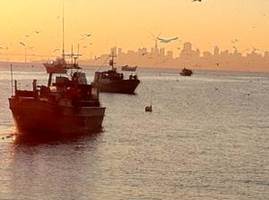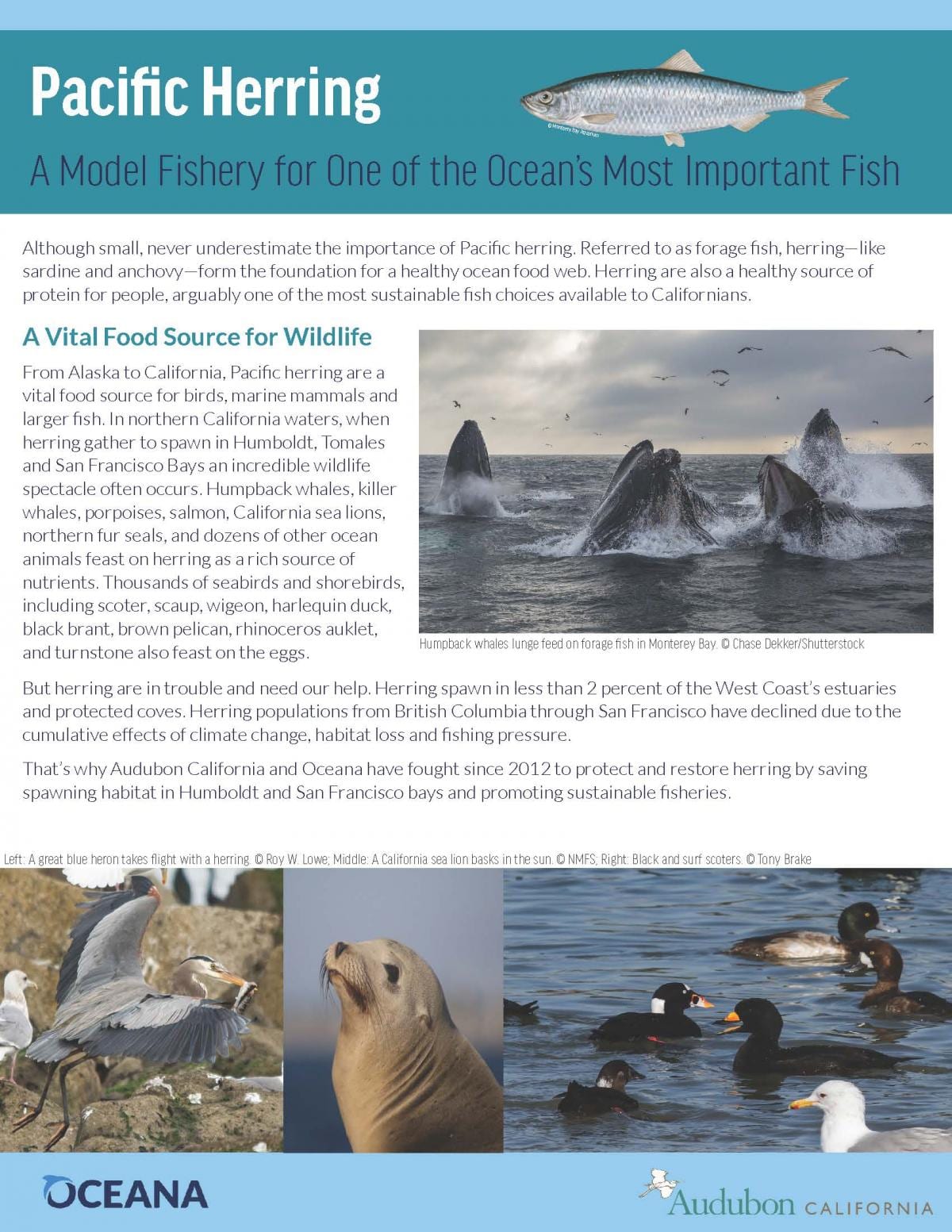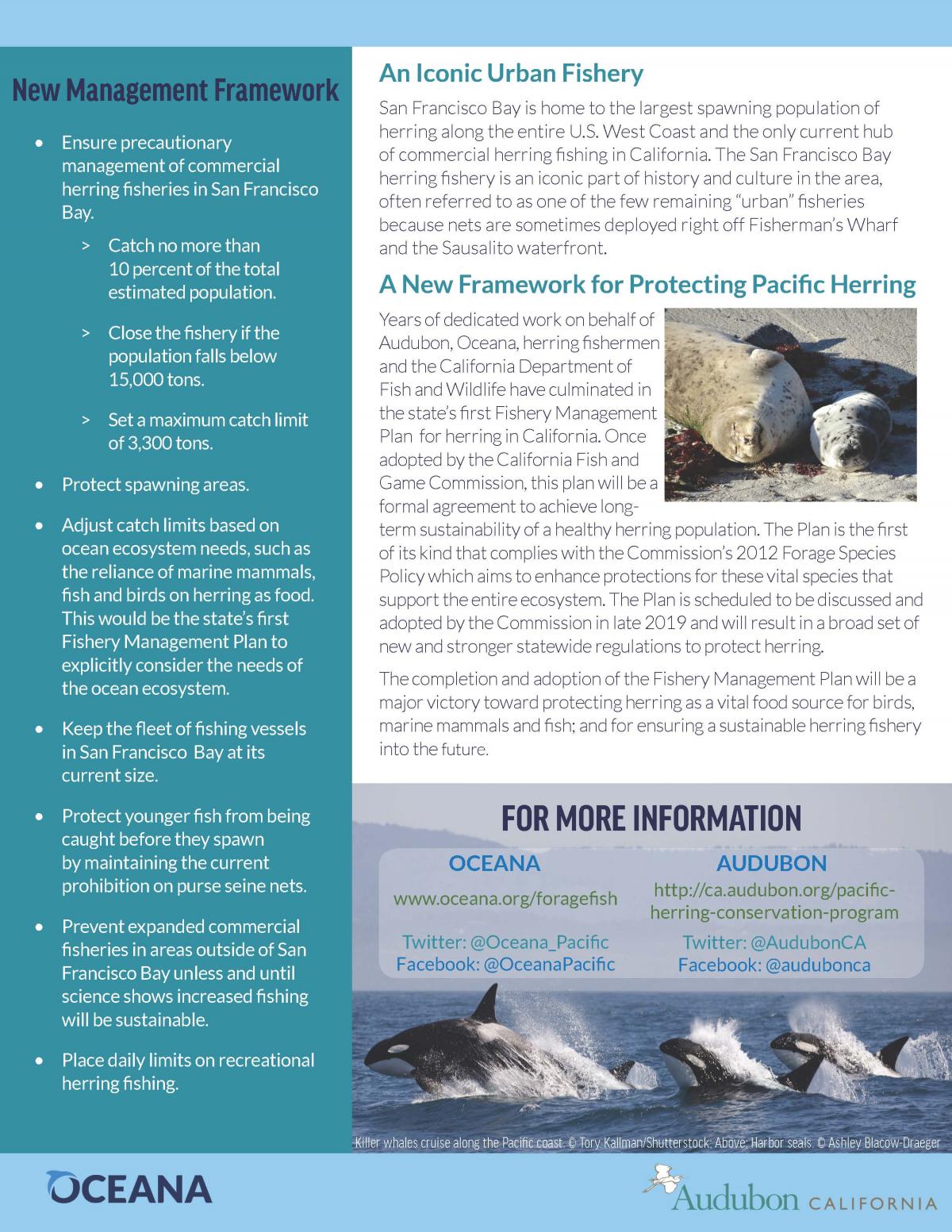Pacific Herring

Pacific herring vary seasonally and geographically in abundance throughout their range from Alaska to California. These small fish are a forage species, and at each stage of their life history from egg to adult they are a source of food for many marine mammals and seabirds.
Pacific herring spawning sparks short-term, frenzied feeding at multiple levels of the marine food web. Animals that prey on herring eggs include juvenile salmonids, sturgeon, smelt, surfperches, crabs and at least 20 species of birds. Adult herring are prey for many seabirds, salmon, seals, California sea lions, porpoises, northern fur seals, killer whales, dogfish, steelhead trout, Pacific cod, sablefish, hake, lingcod, several species of rockfish (black, yelloweye, quillback and tiger rockfish), striped bass, cutthroat trout, sculpin, and sand sole.
In California, herring spawning is known to occur in approximately 12 sites, with the four largest spawning populations in San Francisco Bay, Tomales Bay, Humboldt Bay and Crescent City Harbor.
Pacific herring have also been sought after by both commercial and recreational fishermen over the years. San Francisco Bay, however, is the only current hub of commercial herring fishing in California. The San Francisco Bay herring fishery is an iconic part of the history and culture of the area, often referred to as one of the few remaining “urban” fisheries because nets are sometimes deployed in the city itself right off Fisherman’s Wharf and the Embarcadero and Sausalito waterfronts.
In response to low herring returns in recent years, fishery managers adopted precautionary catch limits below 10 percent of the estimated size of the spawning herring population in San Francisco Bay. In addition, the fishery has a wide array of gear restrictions and many areas are closed to fishing to help protect herring populations.
To help ensure these precautionary measures continue, Oceana partnered with Audubon California, the herring industry, and California fishery managers to develop a first-of-its-kind Fishery Management Plan for Pacific herring that codifies the existing, good management of the fishery while ensuring the needs of the greater ecosystem are also considered. Oceana served on the Steering Committee during the plan development, helped raise funds to complete the plan, and worked with stakeholders to ensure it continues a precautionary management approach and progressively incorporates ecosystem considerations into management, per the California Fish and Game Commission’s 2012 Forage Species Policy, upon which Oceana helped advise. The Plan is the first of its kind that complies with that Forage Species Policy which aims to enhance protections for these vital species that support the entire ecosystem.
The Fish and Game Commission unanimously adopted the Pacific herring Fishery Management Plan in October of 2019.
Click on either image below for a larger version of our factsheet on Pacific herring, which describes this collaborative process and the regulatory changes to the fishery.
The Pacific herring Fishery Management Plan establishes the following long-term management measures for the San Francisco Bay herring fishery:
- Limits annual catch to a maximum of 10% of the estimated spawning biomass, not to exceed 3,300 tons;
- Closes commercial fishing when the population is below 15,000 tons;
- Adjusts annual catch limits based on the food needs of key predators (e.g., Chinook salmon, common murres, and harbor seals), ocean conditions, and the availability of similar alternative prey items, allowing for adaptive management as ecosystem science improves;
- Sets daily limits on recreational herring fishing with cast nets, allowing reasonable continued recreational use while discouraging illegal commercialization of herring caught with recreational gear;
- Maintains existing gillnet restrictions, the prohibition on purse seine gear, and an extensive network of areas closed to fishing; and
- Improves the science to estimate spawning biomass through a new model incorporating climate indicators that can be used following several years of validation.
In addition, the FMP establishes a novel precautionary tier system based on the level of available information and fishery participation to guide future management of herring fishing areas inside and outside San Francisco Bay. Under this system, the FMP:
- Establishes minimal catch limits for historically fished areas outside San Francisco Bay (Tomales Bay, Humboldt Bay, and Crescent City Harbor), which have not been fished in over 12 years. The catch limits are less than 3% of the historic average population size for Tomales Bay and Humboldt Bay and 50% of the historic average catch for Crescent City Harbor.
- Requires new data collection if fishing resumes in an area that is currently unfished to ensure catch limits remain precautionary and inform future management updates.
- Establishes a Rapid Assessment Protocol (a quick version of a stock assessment) for areas outside San Francisco Bay so that fishery managers can ensure sustainability in the event that fishing resumes.
- Prohibits catch limit increases unless and until new biomass estimates and other essential fishery information are collected, consistent with the Commission’s Forage Species Policy.





